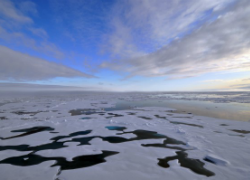
In 2007, a submersible named Mir descended over 4 km to the bottom of the Arctic Ocean and planted the Russian flag under the North Pole. The news broke all over the world and prompted fears of potential violent confrontations between arctic countries. Thus far, such fears have not been realized, but with Arctic sea ice coverage set to hit a record low this year, the Arctic region is not only literally heating up, but commercially. According to satellite data from the US National Snow and Ice Data Center, the Arctic sea ice coverage is already less than the previous record in 2007. Without doubt, the most commonly heard lament is the catastrophic impact this will have on polar bears and other arctic wildlife. What flies under the proverbial radar, however, is the impact that falling sea ice levels will have on global commerce, trade, and politics.
Despite historic trends showing that freshly opened regions often succumb to conflict between competing countries, many believe increased activity in the Arctic will be unusually peaceful. For instance, 95% of Arctic mineral resources are within agreed upon national boundaries. Additionally, operating costs in the Arctic are still enormously high, which encourages joint venture projects and cooperation. Lastly, the Arctic countries, comprised of the United States, Canada, Russia, Norway, and Denmark, want to give the least amount of excuses possible to the rest of the world to begin meddling in the region’s affairs.
As the thaw continues, countries are looking to profit. Canada’s Prime Minister, Steven Harper, recently stated that he believes the “Arctic’s natural resources will propel Canada’s future economic hopes.” The Arctic’s potential has even attracted those from thousands of miles away. The Chinese energy company, CNOOC, has proposed to purchase the Canadian oil and gas producer, Nexen, for $15 billion, in an attempt to access the rich resources in the Yukon and Arctic regions.
The most tantalizing of all, especially for Russia, is the prospect of a new short-cut for trade routes. Last year, the 162,000 tonne tanker, Vladimir Tikhonov, traveled from a Northern port in Russia through the Bering Strait in just seven and a half days, making it the largest vessel to ever traverse the Arctic. Just recently, China set its own record as its first icebreaker traveled along the Russian coast and arrived in Iceland. Passage through the Arctic Ocean remains fraught with danger. It is expensive and icebreakers, needed to facilitate the journey for large commercial vessels, are scarce. The danger of becoming stranded notwithstanding, commercial traffic through the Arctic is increasing every year. Though this spells dollar signs for companies and governments, aboriginal and environmental groups are concerned that aggressive development in the region spells disaster for fragile ecosystems upon which many native populations depend.
The thaw continues, and how countries respond to the competing commercial and environmental interests will unfold only as quickly as the ice melts.


